Exploring the Pacific Ocean: A Comprehensive Overview
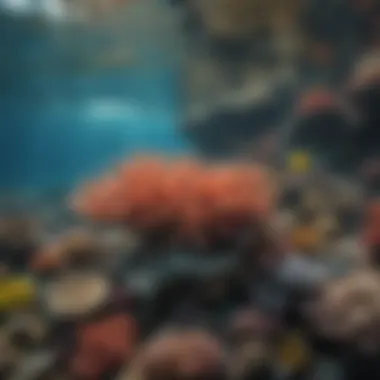
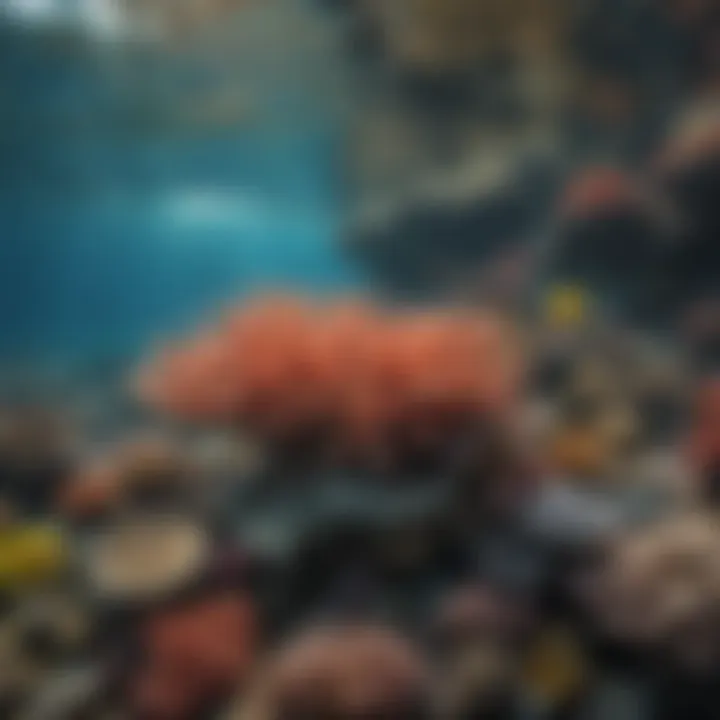
Intro
The Pacific Ocean, more than just a vast body of water, holds a treasure trove of secrets. Stretching across more than 63 million square miles, it is home to a stunning variety of marine life and a rich cultural history. Adventurers and researchers alike find themselves drawn to its immense scale. From the beautiful coral reefs of the Great Barrier Reef to the deep trenches of the Mariana, the ocean is vibrant and teeming with life. It isn't only about exploring, though; it's a complex intersection of culture, environment, and human endeavors.
As we journey through this overview, we will unpack the depths of this ocean, examining its historical significance and its current ecological challenges. By showcasing the importance of conservation and responsible engagement, the narrative highlights how intertwined human existence is with the thriving ecosystems within the Pacific. This is not just an invitation to discover what's below the surface; it's a call to action for sustainability and protection of one of Earth’s most vital resources.
Throughout the sections, we will take a closer look at the essential techniques and skills for navigating this vast space, as well as the equipment needed by watersport enthusiasts ranging from novices to veterans. With the right gear and know-how, the wonders of the Pacific Ocean await those willing to explore.
Preface to the Pacific Ocean
The Pacific Ocean, painting a vivid picture on the Earth’s map, is not just a body of water; it’s a cornerstone of life and culture. Covering an expanse that stretches from the Arctic, all the way down to the Southern Ocean, its size is beyond comprehension. Often considered the heart of the planet, this ocean is a vital player in shaping global climates, supporting diverse ecosystems, and influencing human history.
In presenting this article, we aim to peel back the layers of complexity surrounding the Pacific Ocean. One cannot merely skim over its geographical features or the cultural significance it holds for various civilizations; rather, we’ll dive deep into its multifaceted roles. The Pacific has been a ship’s path, a fishing ground, and a treasure trove of cultural narratives and biodiversity.
For sports enthusiasts and adventure seekers, the Pacific Ocean isn't just a backdrop but a playground teeming with opportunities. It hosts a range of activities, from surfing some of the world’s most formidable waves to exploring vibrant coral reefs while diving. The ocean stands as a bridge between man and nature, allowing us to engage in exhilarating experiences that also require responsible stewardship.
Why This Overview Matters
Exploring the Pacific Ocean is not a whimsical journey but a necessary voyage towards understanding our relationship with the environment. Here are a few key why it matters:
- Ecological Significance: The Pacific is home to countless species, many of which are endemic, meaning they exist nowhere else. Losing even a fraction of this biodiversity poses a risk not just to ocean life but to global ecosystems.
- Cultural Wealth: The ocean harbors stories and traditions. From ancient navigation methods employed by Polynesians to modern-day surfers carving out a name for themselves on its waves, the Pacific narrative is rich and diverse.
- Human Impact: As we navigate through the information, we’ll uncover pressing issues like pollution, overfishing, and climate change. Understanding these challenges is vital for instructors, coaches, and marketers to raise awareness and drive effective conservation efforts.
As we unfold the various chapters of the Pacific Ocean in this article, the objective is to foster a sense of connection and responsibility towards one of the Earth’s greatest resources. Through an engaging examination of its beauty, vulnerabilities, and the human interaction it inspires, we prepare to equip our readers with insights that matter, now and for the future.
Geographical Extent
Understanding the geographical extent of the Pacific Ocean is critical. It helps us grasp how vast this body of water is and its significance in terms of ecological balance and human activities. The Pacific Ocean, stretching over 63 million square miles, offers diverse ecosystems, unique geological features, and cultural significance that are interlinked with the livelihoods of many communities.
Size and Depth
The enormity of the Pacific Ocean is staggering. To put it in perspective, it's bigger than all the continents combined. It boasts an average depth of about 12,080 feet, making it not just the largest ocean, but also the deepest. This tremendous depth houses a variety of geological formations and ecosystems, some which remain unexplored. The Mariana Trench, the deepest point on the planet, draws much attention for its mysterious flora and fauna. While some may view this vastness as simply a vast expanse of water, it embodies a massive reservoir of life and a cradle for scientific inquiry.
Major Landmasses and Borders
The Pacific's borders are vast, as it is flanked by multiple countries and continents, including Asia, Australia, and the Americas. This ocean serves as a natural highway for trade and travel, facilitating cultural exchanges and economic connections. The presence of many island nations such as Hawaii and Fiji adds another layer of complexity. These islands often rely heavily on the ocean for their economies, sustainable practices and tourism. It’s not just sea; it’s the lifeblood for numerous communities.
Oceanic Features
Trenches and Ridges
When one thinks of the Pacific, the image of trenches and ridges cannot be overlooked. The Mariana Trench, for instance, is a remarkable geographic feature that plunges down to nearly 36,000 feet. This trench contributes greatly to our understanding of plate tectonics, and it's a hotspot for unique marine species not found anywhere else. The deep-sea ecosystems here are often described as alien-like, showcasing biodiversity that could hold clues to biological processes essential for our understanding of life on Earth.
One of the key characteristics of these trenches is the extreme conditions that create a habitat for specialized organisms. They also create natural barriers for fish migration and serve as indicators of environmental changes. However, the isolation of these trenches can also lead to vulnerabilities, making their exploration and conservation vital.
Islands and Atolls
The islands and atolls sprinkled across the Pacific are something straight out of a postcard. These unique land formations, like the Marshall Islands and Tuvalu, showcase distinct marine environments that are ripe with biodiversity. These areas are crucial for nesting seabirds and act as nurseries for many species of fish.
What makes these islands compelling is their ecological significance combined with their vulnerabilities. Many are sensitive to rising sea levels influenced by climate change. Their rich cultural heritage adds layers of importance; communities have thrived here for centuries, relying on the ocean's resources for survival. Understanding this unique characteristic also sheds light on the risks these communities face as environmental challenges escalate.
"The Pacific Ocean is not merely water; it’s a vast ecological tapestry woven with rich cultures and intricate relationships."
Historical Context
Understanding the historical context of the Pacific Ocean provides valuable insights into its profound influence on human civilization, navigation, and culture. This section illuminates the journeys of explorers who traversed its vast waters and underscores the ocean's vital role in shaping societies. By delving into this rich narrative, we uncover the connections between geography and human endeavor—an interplay that has crafted the history of entire nations. Moreover, it sheds light on the cultural significance embedded in the diverse communities that have called the Pacific their home, offering key perspectives on how past events continue to shape present realities.
Early Exploration
The saga of early exploration in the Pacific Ocean is a tale of ambition, challenge, and discovery. Explorers such as Ferdinand Magellan and James Cook ventured into the unknown, driven by their thirst for knowledge and the pursuit of new trade routes. Magellan's expedition in the early 16th century, which aimed to find a westward route to the Spice Islands, marked a pivotal moment in maritime history. Though fraught with hardships, including scurvy and hostile encounters, it ultimately resulted in an expanded understanding of global geography.
Similarly, James Cook's voyages in the 18th century charted previously unrecorded islands and coastal regions, stretching the boundaries of what was known about the Pacific. His meticulous records not only enriched cartographic knowledge but also laid the groundwork for subsequent exploration, allowing future generations to navigate these waters more safely and surely. Such efforts provided impetus for European colonial powers, fostering an enduring connection between the ocean and worldwide trade practices.
"The Pacific is the proverbial heart of the world—a vast, uncharted sea that carries dreams of the explorers who dared to cross it."
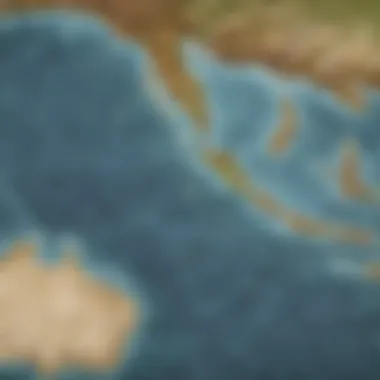
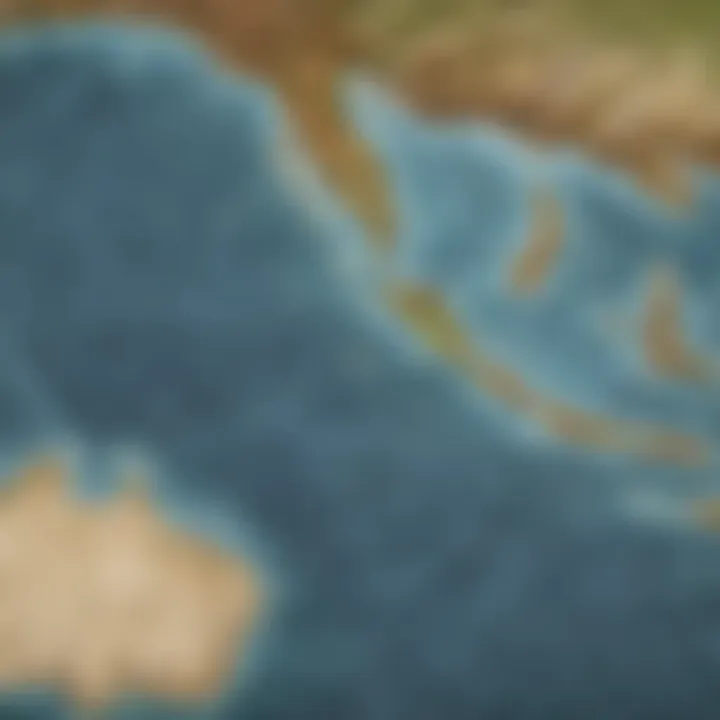
This early exploration wasn't merely about navigation. It dramatically changed the sociopolitical landscape, introducing previously isolated cultures to external influences. The repercussions of these encounters were profound, leading to periods of both cooperation and conflict. In many cases, indigenous communities faced significant disruptions as European powers exercised dominion over new territories.
Cultural Significance of the Ocean
The cultural fabric woven by the Pacific Ocean is as diverse as its expanse. For countless island nations and coastal communities, the ocean serves not just as a means of sustenance but as a core element of identity and tradition. Polynesian navigation, for instance, exemplifies a unique understanding of maritime skills and deep knowledge of ocean currents, star patterns, and weather systems, developed over centuries of seafaring. This expertise manifested in the way Polynesian peoples migrated across vast distances, establishing vibrant cultures across the ocean.
The ocean's significance is also articulated in art, songs, and folklore. Many indigenous stories recount creation myths, connecting the people to the ocean as both a life-giver and a formidable presence. Arts and crafts, often reflecting marine life and the beauty of the waters, serve as cultural markers that celebrate this connection.
In modern society, the legacy of the Pacific Ocean encompasses ongoing dialogues surrounding its environmental conservation. As climate change threatens the delicate balance of marine ecosystems, dialogues increasingly include the voices of indigenous peoples who have long understood the importance of stewardship over these waters. Their traditional ecological knowledge plays a critical role in shaping conservation efforts today, keeping alive the historical connection between culture and the sea.
Ultimately, the historical context of the Pacific Ocean encapsulates a legacy that informs present-day interactions with its waters. From early explorers who charted its depths to contemporary discussions around sustainability, the ocean remains a vital thread linking human history and cultural identity.
Ecological Importance
The Pacific Ocean is not just a vast body of water; it is a thriving ecosystem teeming with life and vital natural processes. This section focuses on the ecological significance of the Pacific, illustrating how its features contribute to the overall health of our planet and the biodiversity that depends on it.
Biodiversity Hotspots
The Pacific Ocean is a treasure trove of biodiversity, often housing some of the most diverse marine environments found on Earth. Marine biologists often point out that areas like the Coral Triangle, which covers parts of Indonesia, Malaysia, and the Philippines, are often considered as the "Amazon of the Sea" due to their sheer number of species.
The region includes over 600 species of coral and around 3,000 species of fish, making it a hotspot that has garnered attention not only from scientists but also from conservationists. These hotspots support intricate food webs and overall ecological stability. Moreover, these diverse ecosystems play a critical role in local economies through fisheries and tourism. The health of these ecosystems is directly tied to climate stability, as they help in carbon sequestration and mitigating climate change effects.
Coral Reefs and Marine Habitats
Coral reefs, often termed as the "rainforests of the sea," are perhaps the most vivid example of the Pacific's ecological richness. These structures are built by tiny coral polyps and provide not just a habitat for thousands of species, but also coastal protection against storms and erosion. In places like the Great Barrier Reef off Australia, the biodiversity is staggering, with over 1,500 species of fish and numerous other marine organisms that call these reefs home.
The interconnectedness of coral reefs with other marine habitats such as seagrass beds and mangroves forms a network that supports marine life at various stages of their life cycles. However, these habitats face threats from coral bleaching caused by rising ocean temperatures, and pollution from land-based activities. Understanding how to protect these habitats is critical for both marine life and human communities that rely on them.
Global Climate Regulation
The Pacific Ocean plays a pivotal role in regulating Earth's climate. It influences weather patterns and is responsible for the majority of the world's oxygen production through phytoplankton. This ocean absorbs a significant amount of the carbon dioxide emissions, acting as a buffer against climate change. In fact, about 25% of human-produced CO2 is sequestered in the oceans, with the Pacific accounting for a large portion of that capacity.
Additionally, phenomena like El Niño and La Niña occur in the Pacific, profoundly influencing global weather patterns. Changes in ocean temperatures not only affect marine biodiversity, but also have ripple effects on agriculture, water supply, and even daily life in many regions around the globe.
"The health of our oceans is directly linked to the health of our planet. Protecting them is not an option; it is a necessity."
Marine Life Types
The Pacific Ocean is home to an extraordinary array of marine life, spanning from the shimmering schools of fish to the majestic cetaceans that roam its depths. Understanding these diverse species is vital not just for ecological balance but also for enhancing our own human experiences, be it through adventure sports or scientific exploration. Marine life types are fundamental in keeping the ocean's ecosystems robust, serving as indicators of environmental health and resilience.
Fish Species
Fish in the Pacific Ocean portray a vibrant mosaic, from the nimble little clownfish darting among reef corals to the massive majestic marlins slicing through the water. These species play essential roles within their ecosystems, often forming intricate food webs. Some notable fish species include:
- Yellowfin Tuna: Highly sought after in commercial fishing, yellowfin tuna is not just popular among sport fishermen; it’s also a significant contributor to local economies focused on sustainable practices.
- Mahi-Mahi: Known for their vibrant colors, these fish are a delight for divers and fishers alike. Their rapid growth and spawning habits make them an ideal candidate for fisheries management efforts.
- Clownfish: Famous for their symbiotic relationship with sea anemones, these small fish are more than just adorable; they also highlight the interconnectedness of marine life.
The presence of each species, whether predatory or herbivorous, underscores the complexity of the Pacific's ecosystems and showcases their responsiveness to environmental changes.
Marine Mammals
The Pacific Ocean also cradles a stunning variety of marine mammals, which include baleen whales, dolphins, and seals. These creatures not only captivate with their grace and intelligence but also play crucial roles in maintaining the ocean’s ecological balance.
Key species include:
- Blue Whale: The largest animal on the planet, blue whales serve as keystone species, helping to regulate the ocean’s ecosystems through their feeding habits.
- Orcas: Often called killer whales, orcas are apex predators with complex social structures. They are vital indicators of ocean health and often reflect the interactions within their marine environment.
- Dolphins: Species such as the bottlenose dolphin are well-regarded for their intelligence and acrobatics, making them popular with both ecotourists and researchers alike.
Understanding marine mammals helps highlight the broader implications of human activities, such as habitat destruction and climate change, on these sentient beings.
Invertebrates and Other Creatures
While fish and mammals often steal the spotlight, invertebrates in the Pacific Ocean form the backbone of marine biodiversity. From the smallest plankton to the largest jellyfish, they are integral to several marine processes.
Some critical invertebrate examples include:
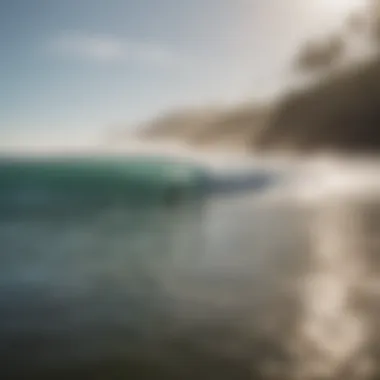

- Corals: As foundational structures in ecosystems, corals create habitats for countless marine species. They also indicate the health of marine environments, as their sensitivity to water quality and temperature changes affect their survival.
- Octopuses: Known for their intelligence and adaptability, octopuses exemplify the diversity of the ocean's life. They contribute to both the food web and as prey for larger species.
- Sea Urchins: These spiny creatures play a crucial role in kelp forests, where their grazing can influence underwater landscapes significantly.
In essence, the Pacific’s marine life types collectively underscore the ocean’s intricate and delicate balance. Their diverse roles not only support ecosystems but also enhance recreational opportunities for those who seek adventure and connection within this vast blue expanse.
Human Impact
The Pacific Ocean stands not just as a beautiful blue expanse, but as a critical player in our planetary ecosystem. Understanding the human impact on this ocean is essential, as it brings to light the benefits, the challenges, and the imperative actions required to ensure its longevity. From the bustling cities on the coast to the remote islands, every action resonates through the ocean's waters.
Pollution and Its Effects
Pollution in the Pacific is an alarming reality. Every year, an estimated eight million tons of plastic finds its way into the ocean, creating vast "garbage patches" that disrupt marine life significantly. The most notable is the Great Pacific Garbage Patch, where debris accumulates due to ocean currents.
- Microplastics infiltrate the food chain, being ingested by fish and other creatures, often making their way to our plates.
- Chemical pollutants from agriculture runoff cause dead zones, regions with low oxygen where life struggles to exist.
The repercussions of this pollution extend beyond marine life. For coastal communities relying on fishing and tourism, the degradation of ocean health translates into economic downturns.
"If we do not address pollution, we are not only harming marine ecosystems; we are jeopardizing our own future."
Overfishing and Its Consequences
Overfishing is another grave concern threatening the Pacific's health. With increasing demand for seafood, fish stocks are dwindling at an alarming rate. The collapsing fish populations impact entire marine ecosystems, leading to a cascade effect.
- Bycatch: The unintentional capture of non-target species disrupts ecological balance and threatens numerous species.
- Economic loss: Local fishing communities are hit hard, as their livelihoods vanish along with the declining fish stocks.
Sustainable fishing practices can mitigate some effects, but often, these solutions are overshadowed by aggressive industrial fishing practices. Exploring alternatives, like aquaculture, might provide feasible paths toward sustainability.
Climate Change and Ocean Acidification
The relationship between climate change and the Pacific Ocean cannot be overemphasized. Rising temperatures contribute to coral bleaching, a phenomenon that sharply reduces biodiversity. When the oceans absorb excess carbon dioxide, it leads to ocean acidification, impacting shell-forming organisms and coral reefs.
- Coral reefs, often touted as the rainforests of the ocean, provide homes for countless marine species and shield coastlines from erosion. Their degradation threatens not only marine life but also coastal communities that rely on these ecosystems for protection and sustenance.
- As the ocean shifts into a more acidic state, species such as mollusks struggle to maintain their shells, subsequently disrupting the food web.
Watersports in the Pacific
Watersports in the Pacific are not just activities; they are gateways to experiencing the vast blue canvas of the ocean in all its splendor. The Pacific, with its stunning vistas and diverse ecosystems, presents numerous opportunities for adventure athaletes. Engaging in these water-related sports brings with it numerous benefits, from physical fitness to the mental well-being derived from being immersed in nature. Moreover, these activities promote appreciation for the ocean, often becoming crucial for conservation awareness. Yet, it is essential to consider the impact on these fragile environments as enthusiasts enjoy the beauty that the Pacific has to ofer.
Surfing: A Cultural Epicenter
Surfing in the Pacific is more than a thrill-seeker's hobby; it's deeply woven into the cultural fabric of many coastal communities. From the lush shores of Hawaii, where the sport flourished, to the breathtaking waves of Uluwatu in Bali, surfing represents a lifestyle. The camaraderie shared among surfers fosters a sense of community, often leading to friendships rooted in shared experiences. It's not uncommon to stumble upon surf schools that cater to both newbies and seasoned riders alike, making it accessible to all.
Beyond the beachfront, surfing plays a significant role in local economies. Tournaments and competitions draw visitors from around the world, bringing in vibrant energy and economic benefits. However, the flip side is that increased popularity can lead to overcrowding and result in damage to beaches and reefs. Understanding the environmental consequences is crucial. Responsible surfing practices, such as respecting local customs and minimizing waste, can help ensure this cultural epicenter's longevity.
Diving Adventures
Diving in the Pacific unfolds a magical realm beneath the waves. Unlike the surface, this underwater world is brimming with color and life. Locations like the Great Barrier Reef and the coral formations of Palau draw divers eager to explore the rich congregations of marine biodiversity. Adventurers often report transformative experiences beneath the ocean, surrounded by anemones, sea turtles, and schools of shimmering fish. It’s not just about the sights, but also about the unique sensory experience—being enveloped by water, buoyed by the current, and the enchanting silence that fills the depths.
Moreover, diving serves as a critical link to eco-awareness. Many dive outfits incorporate educational aspects in their programs, teaching divers about coral reef conservation and the importance of respecting marine life. While exploring our oceans, individuals develop an understanding of the critical threats facing these ecosystems, like coral bleaching due to climate change or damaging fishing practices. By promoting knowledge and sensitivity, diving can become a powerful tool for change.
Kayaking and Paddleboarding
Kayaking and paddleboarding present a different yet equally gratifying encounter with the Pacific. Gliding along the serene waters, adventurers are treated to panoramic views of coastlines, cliffs, and wildlife. For nature lovers, these activities allow a slower pace, providing space for reflection while navigating through lagoons or coastal ecosystems.
The accessibility of these sports cannot be overstated. With kayak and paddleboard rentals easily found along many beaches, anyone can grab a paddle and join in the fun. It’s not just about recreation; these water sports offer excellent exercise, enhancing core strength and balance.
However, enthusiasts must consider their surroundings and adopt environmentally friendly practices. Staying away from nesting areas for birds and respecting aquatic life helps minimize disruption. Moreover, local organizations often conduct cleanup initiatives; participating can amplify the sense of community and the shared goal of protecting the stunning realm of the Pacific.
"Engagement in watersports can transform perspective; what once was just water becomes a living, breathing ecosystem that demands our respect and protection."
In summary, whether it's surfing the waves, diving into the depths, or gliding across tranquil waters, watersports in the Pacific are avenues for adventure, connection, and education. The experiences gained through each of them underscore the need for sustainable practices, ensuring that future generations may also revel in the beauty of this magnificent ocean.
Conservation Efforts
The Pacific Ocean, with its rich tapestry of life and ecosystems, stands at a critical juncture where conservation efforts are imperative. This vast ocean is not just a geographic expanse; it is a cradle of biodiversity and a critical element in regulating global climate. Effective conservation measures help protect marine habitats, sustain fish populations, and mitigate the impacts of human activities. The life that thrived in the Pacific is now under threat from pollution, climate change, and overfishing. Thus, understanding and implementing robust conservation strategies form a cornerstone of any long-term vision for protecting this vital marine resource.
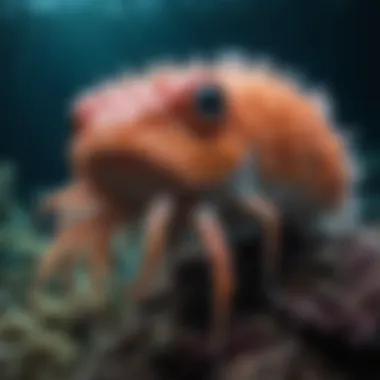
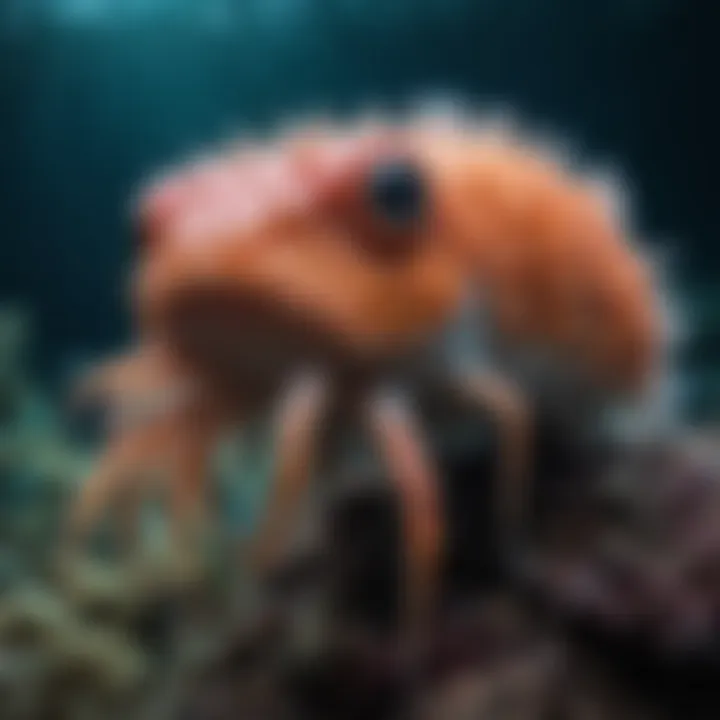
Marine Protected Areas
Marine Protected Areas (MPAs) play a crucial role in safeguarding the health of the Pacific's diverse ecosystems. These designated areas, where human activities are restricted or regulated, serve as refuges for countless marine species. Establishing MPAs fosters recovery and resilience for fisheries and habitats that have suffered due to overexploitation.
- Benefits of MPAs:
- They provide safe havens for endangered species.
- They enable ecosystems to regenerate, creating a spillover effect that can replenish adjacent fishing grounds.
- Protecting critical habitats, such as coral reefs and seagrass beds, enhances biodiversity and promotes sustainable tourism.
The implementation of MPAs is often a collaborative effort involving various stakeholders—from local communities to governments and international organizations. Notable examples in the Pacific include the Papahānaumokuākea Marine National Monument in Hawaii and the Great Barrier Reef Marine Park in Australia. These areas are not only vital for conservation but also serve educational and experiential purposes for visitors.
International Agreements and Initiatives
Addressing the challenges faced by the Pacific Ocean requires a concerted international response. Various agreements and initiatives exist to promote sustainable practices and protect marine resources. Some of these efforts include:
- The Convention on Biological Diversity (CBD): A global treaty aimed at conserving biological diversity and promoting its sustainable use. This agreement encourages nations to establish protected areas and better manage marine ecosystems.
- The United Nations’ Sustainable Development Goals (SDGs): Goal 14 specifically highlights the importance of conserving and sustainably using the oceans, seas, and marine resources. It emphasizes the need to minimize pollution and protect marine habitats.
- Regional Fisheries Management Organizations (RFMOs): These organizations regulate fish stocks and fisheries in the Pacific, aiming to prevent overfishing and ensure sustainable practices.
"In a world that often prioritizes short-term gain over long-term survival, it is vital to think globally and act locally to ensure the preservation of our oceans for future generations."
Achieving the objectives set forth by these initiatives necessitates the cooperation of all stakeholders, including governments, local communities, and non-governmental organizations. Engaging in dialogue, sharing knowledge, and fostering transparency are fundamental to advancing conservation efforts in the Pacific.
In summary, the conservation efforts in the Pacific are not merely about protecting the ocean; they are about sustaining the livelihoods and cultural identities of the communities that depend on it. By prioritizing Marine Protected Areas and adhering to international agreements, we pave the way for a healthier, more sustainable future for one of the world’s most important natural resources.
Future Directions and Challenges
The pressing matter of future directions and challenges regarding the Pacific Ocean is not merely an academic exercise but a vital necessity for the planet’s health. Given the ocean's critical role in climate regulation, biodiversity, and global economies, understanding this topic sheds light on the tangible impact of our actions now and into the future. Failing to address these challenges could precipitate dire consequences that affect not only marine ecosystems but also human livelihoods.
Sustainable Practices in Fisheries
Fisheries management stands at the intersection of human necessity and ecological preservation. Sustainable practices are of paramount importance here; they help ensure that fish stocks remain healthy for future generations. Overfishing remains a significant concern, threatening marine biodiversity and the livelihoods of those who depend on fishing. Therefore, adherence to principles such as catch limits and responsible fishing techniques can mitigate some of these stresses.
- Adaptive Management: Fishery operators need to implement adaptive management techniques which allow for rapid responses to changing marine conditions. Learning from past practices is crucial.
- Community Involvement: Engaging local communities in decision-making processes ensures that those who fish the waters have a vested interest in their sustainability.
- Marine Stewardship: Promoting certifications that encourage sustainable practices can help consumers make more informed choices about seafood.
These sustainable practices are not just beneficial; they are essential for maintaining a balance between our needs and the health of the oceanic environment.
Technological Innovations for Conservation
Innovation plays a fundamental role in addressing the challenges facing the Pacific Ocean. As technology advances, new methods emerge that can lead to better conservation outcomes. Utilizing technology effectively can enhance our understanding of marine ecosystems and improve conservation efforts.
Some noteworthy innovations include:
- Remote Sensing: Satellite technology allows for large-scale monitoring of ocean health, helping scientists to track changes in temperature, salinity, and marine life distribution effectively.
- Drones: Unmanned aerial vehicles can gather data from remote or otherwise inaccessible parts of the ocean, providing valuable insights into habitat conditions without disturbing marine life.
- Artificial Intelligence: AI systems are able to analyze vast amounts of data, predicting fish population trends, which can inform fishing quotas and timing.
Investing in these technological innovations could well be the game-changer needed to help safeguard the Pacific Ocean's resources.
In summary, the road ahead involves a concerted effort to implement sustainable practices in fisheries and embrace cutting-edge technology for conservation. By making informed and conscientious choices today, we can work towards a healthier ocean tomorrow. Engaging the stakeholders within the fishing industry alongside tech innovators can pave the way toward a sustainable future, highlighting both the urgency and the possibility of positive change.
Ending
In this comprehensive exploration of the Pacific Ocean, we've traversed its majestic reach, examined the richness of its biodiversity, and considered the profound impact humans have on this vast body of water. The conclusion ties all these threads together, underscoring the central thesis of the article—that the Pacific Ocean is not merely a vast expanse of water, but rather a complex network of ecological, cultural, and recreational significance.
Importance of the Pacific Ocean
The Pacific is not just the world’s largest ocean; it’s a critical player in maintaining global weather patterns and climate. It houses marine biodiversity that is essential for ecological balance, with coral reefs acting as nurseries for countless species. Moreover, it serves as a source for food, livelihoods, and recreation for millions across its shores. The ocean's health directly affects the health of coastal communities and environments.
Key Takeaways
When reflecting on the impacts of human activities, we see that pollution, overfishing, and climate change impose severe threats to this precious resource. Conserving and protecting the Pacific Ocean is not merely an ecological responsibility but a moral imperative to ensure future generations can enjoy its bounty.
"The Pacific Ocean stands as both a treasure and a challenge, demanding stewardship that balances our need for resources with respect for its ecosystems."
Looking Forward
In considering future directions, embracing sustainable practices in fisheries, alongside fostering international cooperation through initiatives and agreements, emerges as a significant pathway. Technological advancements, such as enhanced monitoring systems for marine protected areas, can play a pivotal role in advancing conservation efforts.
Closure's Relevance
Ultimately, the conclusion of our narrative emphasizes that understanding the Pacific Ocean's multifaceted role enriches our perspective and deepens our appreciation for this ecological wonder. The call to action is clear—responsible stewardship is essential. Whether you are an adventurer seeking thrills or an educator imparting knowledge, recognizing the intrinsic values of the Pacific Ocean is crucial for both personal and collective growth.
In wrapping up, our exploration serves as a reminder that with knowledge comes responsibility, illuminating the interconnectedness of human activities and natural systems within this remarkable oceanic domain.







